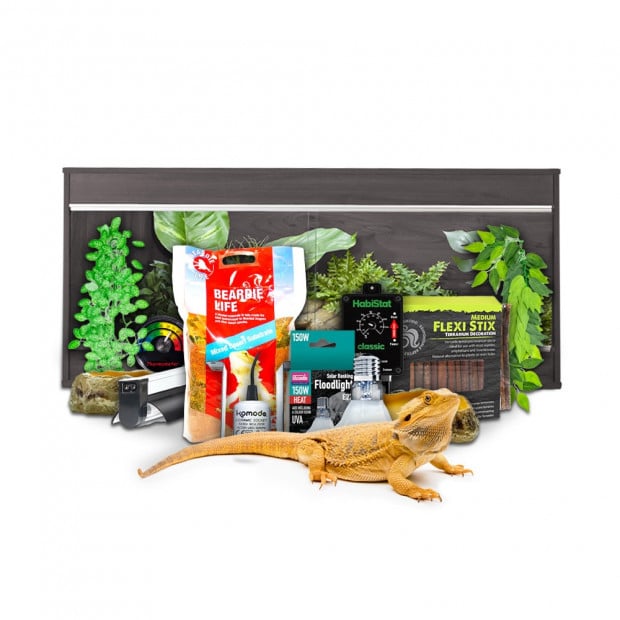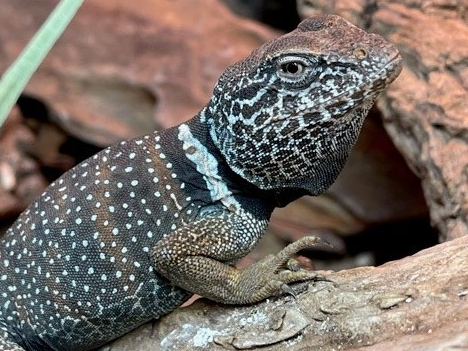-
Categories: Care sheetsLizards
Desert collared lizard, Crotaphytus collaris, care sheet
Desert collared lizard, Crotaphytus collaris, husbandry guide from the experts at Swell Reptiles, covering housing, heating, lighting and more.
Desert collared lizard, Crotaphytus collaris
Intelligent and highly rewarding - the Desert collared lizard

- Desert collared lizards pose an interesting challenge to keepers
- A highly active reptile that you can have a lot of fun with
- Often skittish but can be tamed and tolerate handling
Do Desert collared lizards make good pets?
Desert collared lizards are a highly active species that naturally roams the arid, rocky grassland and desert habitats of North America. They can be quite skittish and defensive, they can be tamed if enough time and effort are put into this, although, as they are not necessarily small lizards, this makes them a better choice for intermediate or advanced hobbyists.
At Swell Reptiles, all of our Desert collared lizards are captive bred in the UK, so if you purchase from us you can be safe in the knowledge that your new reptile came from a reliable source without having a negative impact on the environment.
Which enclosure should I choose for my Desert collared lizard?
Due to their high activity levels, Desert collared lizards need an enclosure size to match this, therefore we recommend a minimum adult enclosure size of 120 x 60 x 60cm (4 x 2 x 2ft). As they also have high temperature requirements, a wooden vivarium will be the best housing option due to its ability to hold heat better than glass terrariums. Therefore, a good option would be the VivExotic Repti-Home Bearded Dragon Vivarium Large.
What temperature should a Desert collared lizard be kept at?
As with all reptiles, Desert collared lizards are ectothermic and cannot control their own body temperature. We, therefore, need to provide them with a thermogradient that runs from hot-cool from one end of the enclosure to the other, so that if they need to warm up or cool down they have areas to do both in. The ideal basking temperature for this species is between 38-42°C (100-107°F) and their cool end should sit at around 28°C (82°C). During the night the temperature can be allowed to drop as it would naturally to no lower than 15°C (15°F) meaning in most instances overnight heating is not required.
The thermogradient should be created using an overhead heating system in the form of a basking lamp or ceramic heater, either of which must be hooked up to a compatible thermostat. If you opt for a basking lamp, you will need to also purchase a dimming thermostat, whereas you will need a pulse thermostat for a ceramic heater. It is important to check the maximum temperature of your chosen thermostat, as you may need to choose a high-range thermostat if your chosen one does not support such high temperatures.
Do Desert collared lizards need UVB?
Desert collared lizards should be kept within a UVI range of 3-4 to ensure they are able to metabolise vitamin D3 and make full use of the calcium provided in their diet. The percentage of UV required depends on the distance between the light fixture and the basking area, so if this will be between 30-40cm (12-15”), an Arcadia ProT5 Kit - Forest 6% should be used, whereas if this will be between 40-60cm (15-24”), an Arcadia ProT5 Kit - Desert 12% should be used.
What humidity levels are required for a Desert collared lizard?
The clue is in the name with this species, Desert collared lizards inhabit arid, desert habitats that are known for being very hot and very dry. The ideal humidity range sits between 40-50% which is on the lower end of the average room humidity in the UK, meaning little will need to be done to maintain these levels.
A sandy substrate that does not retain moisture, such as ProRep Leo Life or Arcadia EarthMix Arid for bioactive set-ups should be used here. You can, however, provide a moist hide in the cool end of the enclosure, which would be a hiding cave filled with damp reptile moss. This will give your lizard a humid area that they can go to during the shed cycle without increasing the overall humidity in the enclosure.
How do I decorate a Desert collared lizard’s vivarium?
A minimum of two hiding areas should be provided for Desert collared lizards, one in the warm end and one in the cool end so that they have a safe space across the entire thermogradient. This can be done using traditional hiding caves, cork bark rounds or half rounds and plenty of foliage either from live or artificial plants. A shallow water dish should also be placed in the cool end, to provide hydration without increasing the overall humidity within the enclosure.
What do Desert collared lizards eat?
Desert collared lizards are insectivorous and should be fed a varied diet of different livefoods. Crickets, locusts and cockroaches make good staple options, with other feeders such as waxworms and beetle grubs being a good choice for occasional feedings or treats.
To ensure all of the nutrients your Desert collared lizard needs are provided within their diet, all livefood should be dusted with supplements according to a strict cycle. For this, we recommend using a calcium-rich multivitamin on every feed, such as Arcadia EarthPro-A, a calcium plus magnesium supplement on every fourth feed, such as Arcadia CalciumPro Mg and finally, a vitamin D3 supplement on every eighth feed such as Arcadia EarthPro RevitaliseD3.
How do I buy a Desert collared lizard?
If you like the look of our UK captive bred Desert collared lizards and would like to purchase one, you will need to collect this from our superstore so please come down and see us.
To ensure any livestock sold by us only goes to suitable homes, we will ask a few quick questions and to see some photos of your set-up, which should be completely ready for the animal to go into. We reserve the right to refuse adoption to anyone we feel is unprepared to adopt.
For more detailed husbandry information, please see our Desert Collared Care Sheet. You can also learn more about reptile care on our blog, with loads of useful articles like our Ackie monitor care sheet.
| Common names | Desert collared lizard, Common collared lizard, Eastern collared lizard |
| Scientific name | Crotaphytus collaris |
| Country | North America |
| Captive-bred | Yes |
| Adult size | 30cm (12”) |
| Natural habitat | Arid, rocky grassland and desert habitats |
| Housing | 120 x 60 x 60cm (4 x 2 x 2ft) |
| Ideal temperature | 38-42°C (100-107°F) (warm end); 28°C (82°C) (cool end) |
| UVI | 3-4 |
| Ideal humidity | 40-50% |
| Diet | Insectivorous |
| Average lifespan | 7-10 years |
| Personality | Skittish |
| Ease of handling | Moderate |
| Cohabitable | No |
-
 Ornate plated lizard, Zonosaurus ornatusFrom £60.00Out of stock
Ornate plated lizard, Zonosaurus ornatusFrom £60.00Out of stock







